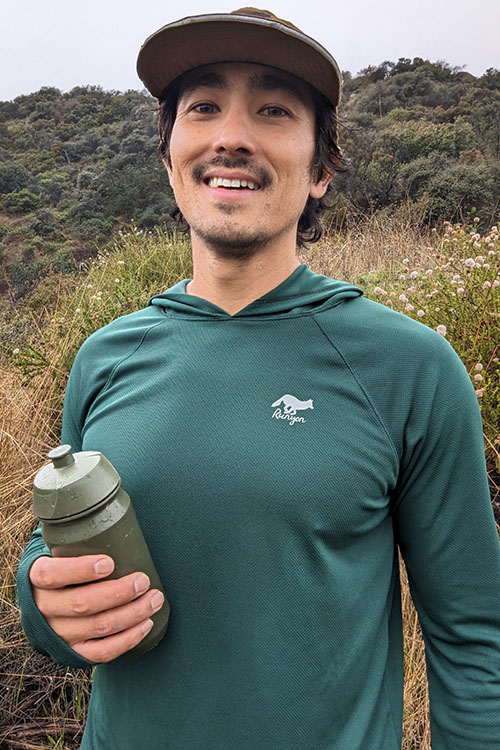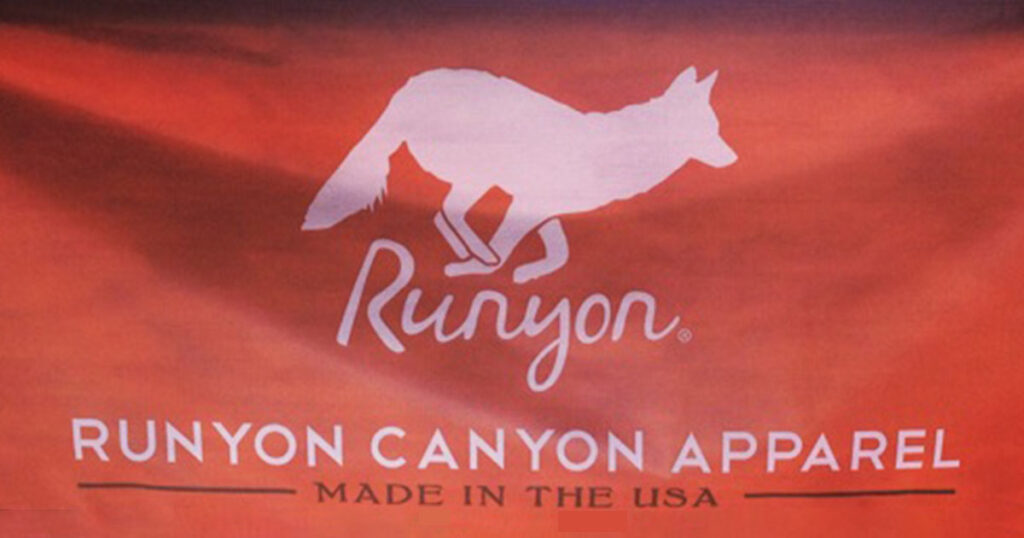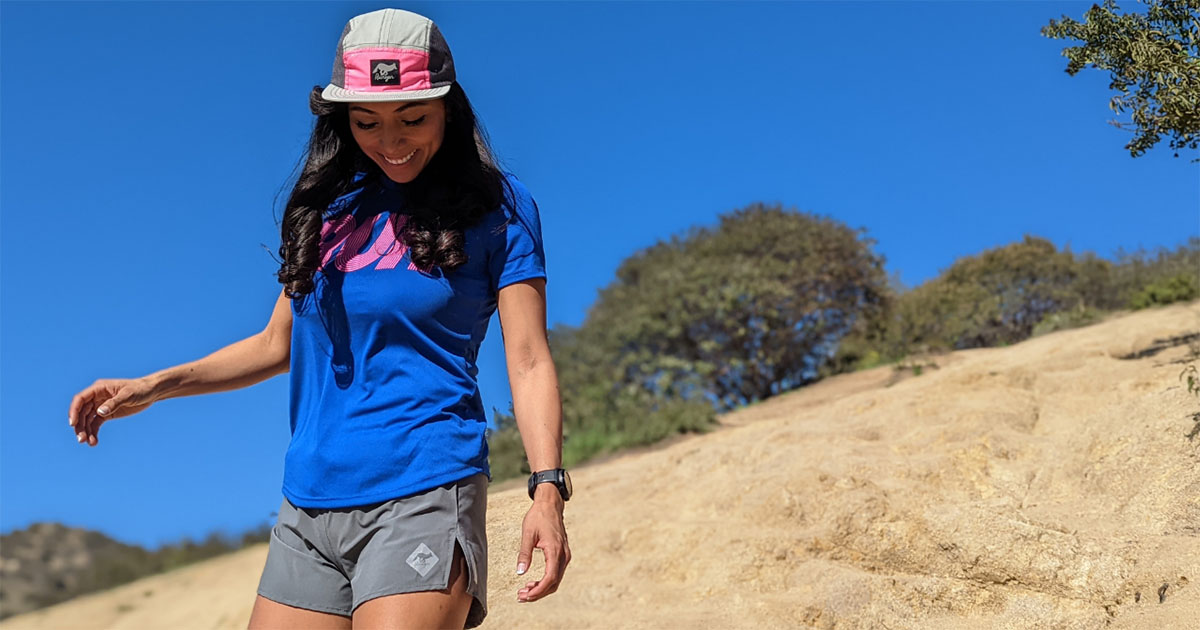How Runyon Canyon Apparel is building an all made in USA fitness brand.
Amidst a flood of imports dominating the apparel industry, Runyon Canyon Apparel, a Los Angeles-based fitness brand, distinguishes itself by making all of its clothing within the USA. I had the privilege of sitting down with its founder, Tony Nuccio, to talk about what made him start Runyon, how he built up the company over the past 10 years and the challenges he faced along the way.
Throughout our conversation, I not only learned a lot, but was also inspired by his dedication to values; not just when it comes to American manufacturing, but in terms of protecting American culture and wildlife as well. I hope I can convey some of it to you through this article.

How Runyon got started.

When talking to Tony about his past experiences, you can clearly see the pieces of the puzzle that will become Runyon slowly being laid out.
Being athletic from a young age, he got involved in a range of sports, from baseball to skiing. By his late twenties, this had evolved into a love for running and he began participating in marathons and triathlons.
However, his career would take a different direction when he took a marketing job at a small California-based record label called Hidden Beach Recordings, which focused on upholding and preserving soul music. It was here that he learned about consumers’ values and witnessed firsthand their passion for things close to their hearts.
After a decade of working in the music industry, the time was ripe for change. So around 2012, noticing how little fitness apparel was still made in the USA, his athletic side and love for authenticity came together and Runyon Canyon Apparel was born. The goal was to create a fitness and outdoor fashion brand focused on upholding an authentic sense of American style by actually making the clothing inside the USA.
The journey so far.
With no experience in the fashion industry and no backing of large investors, getting Runyon off the ground was no easy feat. Fortunately, living near Los Angeles, Tony had one of the last big apparel-manufacturing centers within the USA around the corner. This made it easier to find contractors that were able to cut and sew the apparel, as well as mills to source fabrics from.
Yet, even California lacks the full service packages that you can find in many Asian countries, making it hard to find people specialized in certain steps of the production process.
As a result it was often up to Tony himself to get the finished garments created and out the door. This meant actually becoming a person who knew how to make clothing and learning to do things like screen-printing and heat-transferring himself. Even to this day, a lot of items are still decorated in-house and have passed through his hands.
Where is Runyon apparel made?
Currently all of Runyon’s products are made in the USA, mostly using American made fabrics that are knitted and dyed in California using yarns sourced from the East coast. As Tony emphasized, the goal is always to achieve 100% made in the USA. A good example being their zip hoodies which feature American made zippers, drawcords and even eyelets!
The few exceptions where this isn’t case are often due to circumstances beyond his control. In case it’s important to you that your shirt or shorts are indeed 100% American made, it’s always clearly stated on the Runyon website whether the fabric is made in the USA.
Supporting the environment: the Wild Buck
If that wasn’t enough, Runyon is also trying to help preserve the local wildlife and environment. Through their Wild Buck initiative, they donate $1 for every item sold to charities or initiatives like Citizens For Los Angeles Wildlife, the Raptor Center and the National Wildlife Federation. It was clear that this is a cause near and dear to Tony’s heart as he talked about potential future plans for the initiative, ranging from protecting local land from development to planting wildflowers.
But building a brand this way certainly doesn’t come without its fair share of challenges.
The struggles of creating a Made in USA fitness brand.
Much of my conversation with Tony revolved around the struggles of creating a made in the USA fitness brand. While these challenges certainly aren’t unique to Runyon, I wanted to outline them here because I think it’s important for everyone to be aware of them.
And even though I’m already fairly familiar with most of these issues, I still learned a lot, with plenty of interesting facts and specific challenges I hadn’t considered before coming up.

Finding American made yarns and fabrics
Even though Runyon uses almost exclusively American-made fabrics, that isn’t necessarily an easy thing to do, mainly because the available selection is far smaller.
One example Tony gave me is the fact that you’re almost exclusively limited to knitted fabrics, as the few American manufacturers of woven fabrics tend to prioritize bigger contracts for aerospace or military applications and don’t typically sell to the apparel industry. This means that his Runyon shorts have to be made from knitted fabrics rather than woven ones, which are more commonly used in the industry. And even for knitted fabrics, your range of available variations or patterns is far more limited compared to imported ones.
Another example was the difficulty of finding yarns for the patches on their trucker hats, where he could only find one company that still manufactured those in the USA.
Higher manufacturing costs that limit your options
Often, the deal breaker when people consider manufacturing in the USA or overseas, and by far the most expensive part of the production process, is the actual cutting and sewing of the garment. The truth is that most garment workers in places like Vietnam or Bangladesh only get paid $100 – $200 per month.
Compare this to the average garment worker in the USA who gets paid $15/hour on average, and you’ll find that what it will cost you to employ a garment worker overseas for a month, will only get you a day or two of labor from an American worker.
This makes it inevitable that American-made clothing is more expensive than that which is made overseas, something most of us are already aware of. However, what many don’t realize is that this difference grows exponentially with the complexity of the garment. Take a look at the examples below:
| Garment | Time to sew | USA cost | Imported cost | Difference |
|---|---|---|---|---|
| Simple T-shirt | 30 minutes | $7.5 | $0,5 | $7 |
| Detailed t-shirt | 1 hour | $15 | $1 | $14 |
| Jacket | 5 hours | $75 | $5 | $70 |
You’ll see that if someone is willing to pay a couple of extra bucks for something made in USA, the company accepts lower profit margins, or you can save a little on shipping, you can probably get away with making a t-shirt in the USA. But for more complex apparel, that difference in price quickly becomes a large pill to swallow, even for the conscious consumer.
While talking to Tony, the reality of this really hit me. He gave the example of an imported tactical jacket he owns which features a whole bunch of zippers and other detailing, which he knew he could never even convince an American factory to produce, because each one would cost a relative fortune. So reducing the time spent on a single garment is a real priority: cutting unnecessary stitches and trying to keep the whole garment as simple as possible.
In short: you have to design your apparel in a specific way in order for it to be made in the USA. You’ll have to try and minimize the hours spend in production, which not only limits the creativity you can put into a garment, but also determines the types of clothing you can produce in the first place.
Finding capital and surviving in a competitive marketplace
When I asked Tony what his biggest struggles were when starting Runyon, I expected him to talk about the issues mentioned above. However, he named the difficulty of raising capital and getting the word out about the brand as his biggest challenges instead.
And while these are issues faced by any business, when you’re also more limited in your designs and have to deal with higher manufacturing costs (which in turn means lower profit margins), they can become extra challenging. Especially because your competitors can use their higher profit margins to fund marketing campaigns or attract investors.
The way Tony and Runyon are tackling this challenge is by getting creative. Instead of borrowing a lot of money to invest in a vast selection or marketing campaigns, they aim to grow the brand organically through word of mouth and by enhancing their visibility on search engines like Google.
Their goal is to steadily grow the company, expand their selection and build a strong foundation, after which they could potentially partner up with a bigger brand to take Runyon to the next level.

Some key takeaways I would like to share
Throughout our conversation, there were two things about Tony that really stood out to me, which I would like to share. And no, he didn’t pay me to write this article; these are my own genuine impressions.
First of all, his dedication to values. Whether he’s talking about making clothing in the USA, protecting the environment, or preventing the exploitation of workers in other countries, he truly struck me as someone who cares about the state of the world. He isn’t afraid to put his money where his mouth is and actually try to make things just a little better, even though that’s definitely not the easiest or most profitable path to take.
Secondly, it struck me how balanced and subtle his points of view are. When talking about why he decided to make Runyon apparel in the USA, I didn’t get a sense of blind nationalism or demeaning of other countries. In fact, he quickly dispelled the notion that products made overseas are necessarily of lower quality and emphasized that it’s important not to diminish the work done by the people making those products.
Another interesting point he made, which I myself hadn’t considered yet, was his criticism of the ‘Designed in the USA’ label. Rather than just criticizing the fact that it’s misleading people into thinking a product is made in the USA, he also took the point of view of the country that’s manufacturing the garment, questioning why they should manufacture garments designed overseas rather than making something inspired by their own culture.
“A lot of the time, there’s this label that says ‘designed in USA, made in Vietnam’ for example; why can’t it be designed in Vietnam and made in Vietnam? I would think that’s a lot sexier than trying to leverage this ‘designed in USA’ label.”
Tony Nuccio
To him, making something in the USA seems to be a matter of authenticity and culture, which I found to be a new and fascinating point of view.
Go check out Runyon!
After our conversation, I will definitely be ordering some Runyon apparel for myself, and if you’re in need of some first-class athletic wear, I encourage you to do the same!
They offer a pretty impressive, affordable, all American-made selection for both men and women, which includes tees, tank tops, hoodies, shorts, hats, and more. All of which comes with free US shipping on orders over $50 (and yes, they also ship internationally!), free 30-day returns, and the possibility to include a hand-written note when gifting!
Not only will you be getting some quality, American made sportswear, you’ll also be supporting a company that, in my opinion, really is dedicated, in more than one way, to making this world a better place; which seems like a pretty good deal to me. If you’re not quite convinced, you can also have a listen to Tony as a guest on the the Manufacturing Report podcast.

Leave a Reply
You must be logged in to post a comment.